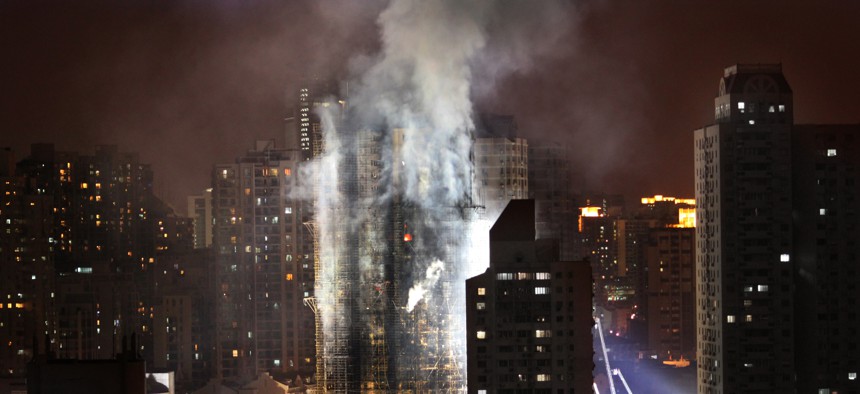All eyes on the FCC as deadline for 911 overhaul approaches

Fabien Recoquille / Getty Images
By enforcing its z-axis requirements and moving toward nationwide deployment, the Federal Communications Commission can fundamentally transform national emergency response.
Ingrained in the minds of every American is a number that each of us hopes to never call, 911. But in life’s most vulnerable and harrowing moments, 911 is a lifeline to critical support and sometimes life-saving services. The premise is simple: We’re just one phone call away from emergency services including police, firefighters or emergency medical assistance. Yet this promise can only be fulfilled with precise location intelligence.
Protocol requires emergency dispatchers to ask 911 callers for their address or location, but this information may not be precise enough, especially in time-sensitive situations. Further, callers may be in situations of extreme distress and left unable, or unwilling, to share their location. In these scenarios, dispatchers and first responders rely on location intelligence technology provided by the wireless carriers. Today, even this location intelligence falls short in providing precise geolocation; it lacks the ability to share a caller’s vertical location – also known as z-axis – which is critical in cities where multistory buildings dominate the cityscape.
In 911 calls, every second matters
We live in a three-dimensional world where altitude can be the difference between rapid response and delayed support. In this life-saving equation, it’s most effective to equate distance with time. For example, a dispatchable first responder may be only minutes from a caller’s address, but if that address corresponds to a high-rise building, vertical location becomes vital to quickening response. The time spent working to understand a caller’s vertical location can delay response by seconds or minutes, diminishing emergency response outcomes and potentially putting first responders in harm's way. Delays due to a lack of location intelligence are a matter of life or death for both the caller and emergency responders across situations but especially in fire emergencies where locating individuals becomes extremely challenging.
The significance of vertical location in enhancing emergency response cannot be understated. In fact, it’s been found that vertical location could save upwards of 10,000 lives per year if deployed. Understanding the positive impact vertical location would have, the Federal Communications Commission has moved toward requiring the capability since 2014. FCC Chairwoman Jessica Rosenworcel acknowledged that z-axis enforcement has “evaded the agency for too long.” In a move to finally bring z-axis to market, Rosenworcel has led the FCC in requiring that wireless carriers deploy z-axis capabilities across the top 25 cellular markets by April 3, 2022. After years of negotiations, testing and development, the FCC, alongside the wireless carriers, is set to finally bring this life-saving capability to communities across the U.S.
Precise Z-axis can be deployed today
Vertical location technologies that meet the FCC’s accuracy requirements – within 3 vertical meters of a caller’s altitude – exist today and have already been deployed across the public safety community. Z-axis technologies currently power applications across the public safety industry, including FirstNet Built with AT&T, the RapidSOS and Intrepid Networks’ Locate Standard for FirstNet. While these solutions deliver z-axis capabilities to support first responders in emergency situations, they do not deliver the z-axis intelligence around a caller’s location – yet.
This is where the FCC is critical. In requiring the delivery of z-axis capabilities by nationwide wireless carriers, the FCC will broaden the efficacy of emergency response across the U.S. Deployment of vertical location technologies in public safety applications has shown that this technology is ready for widespread implementation. Now, it’s just a matter of adoption among the wireless carriers to bring this to every cell phone in the country.
The clock is ticking on z-axis deployment
In a string of recent announcements, it seems the carriers are beginning to move toward meeting the FCC’s requirements. Leading providers of z-axis solutions recently announced partnerships with top-tier wireless carriers to bring vertical location capabilities to market. As the June certification date looms, these partnerships are an encouraging sign that the carriers are doing their part.
In enforcing its z-axis requirements and moving toward nationwide deployment, the FCC has an opportunity to fundamentally transform our national emergency response system. As agencies and citizens deal with increases in crime, unrest and concern around first-responder safety, the FCC is set to take a critical step in enhancing the lifeline that millions of Americans rely on in their most vulnerable moments. Now, we wait to see how they’ll proceed – with the hope it will be with a life-saving sense of urgency.
Chief Charles L. Werner (Ret.) has served 47 years in public safety. Werner started his career as a firefighter with the Charlottesville, Virginia, fire department, serving 37 years before leading the department as fire chief for 10 years. He also served two years as a reserve deputy with the Albemarle County Sheriffs' Office. Following retirement, Werner went on to serve two years as senior advisor and deputy state coordinator for the Virginia Department of Emergency Management.





